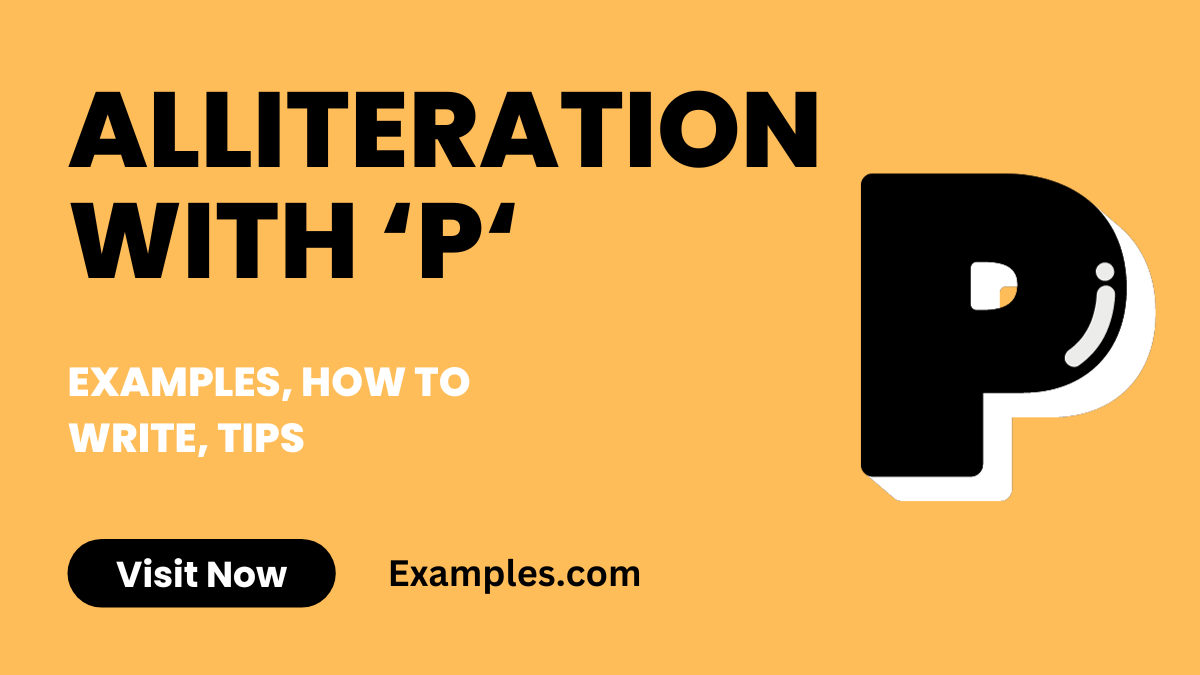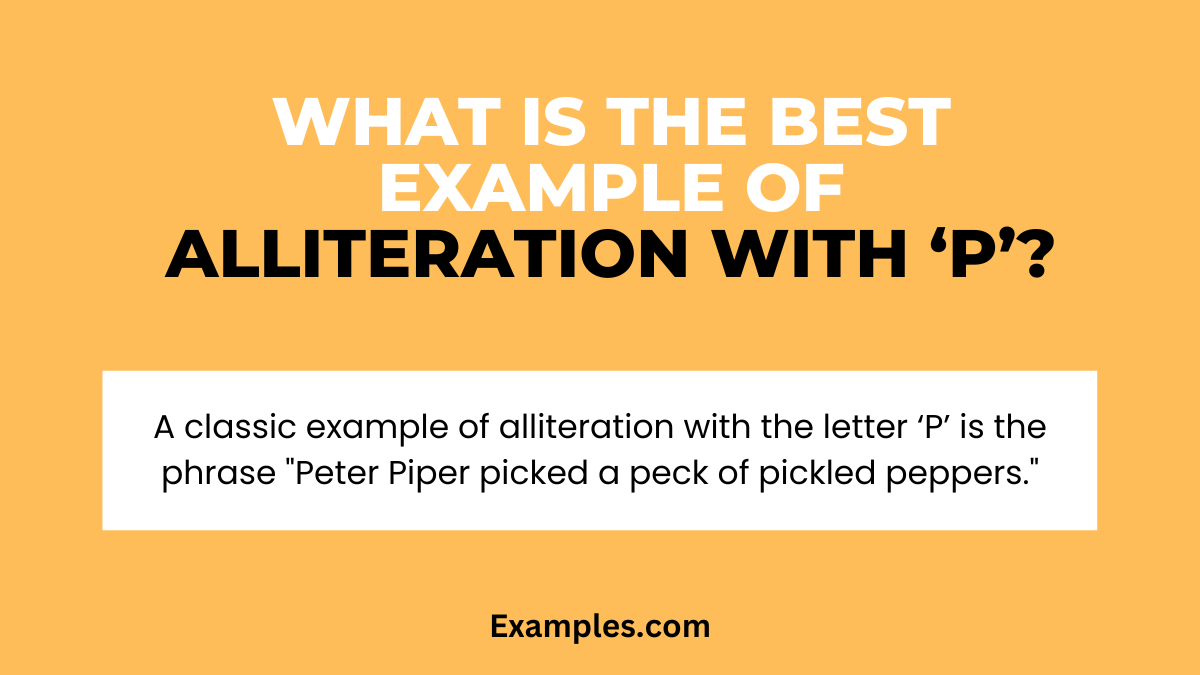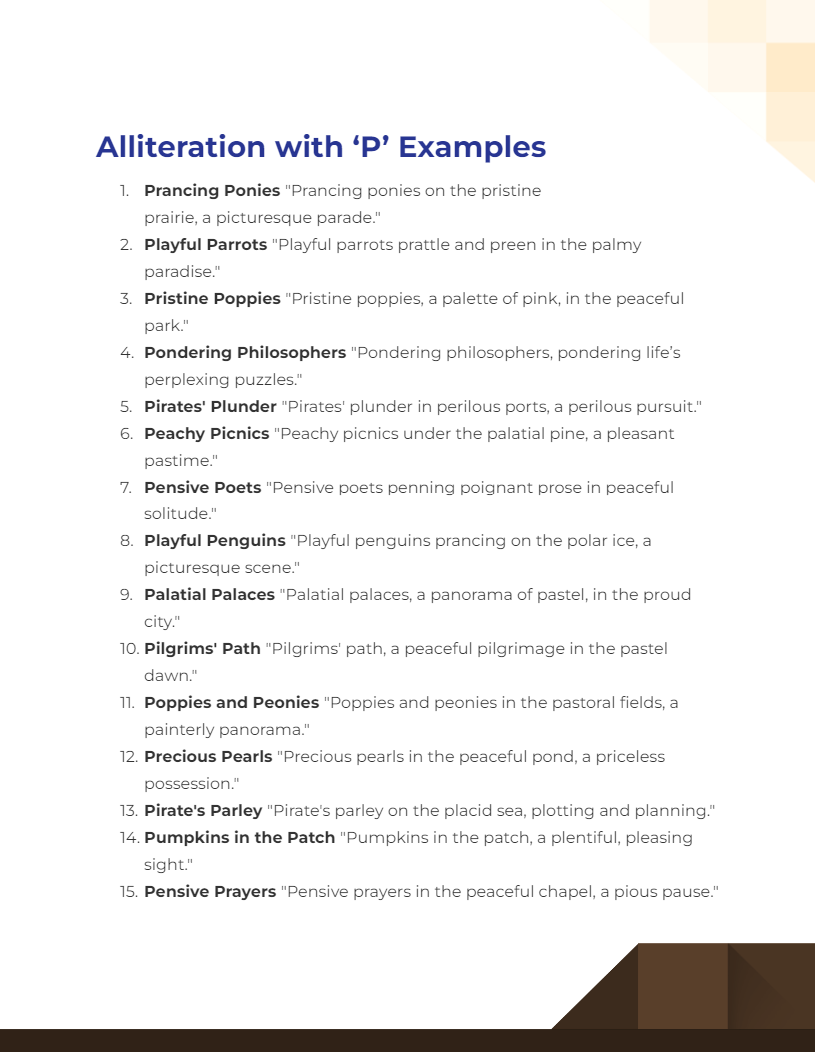

Alliteration with the letter ‘P’ possesses a particularly powerful and punchy presence in literature and speech. This form of alliteration, which involves the repetition of the ‘P’ sound at the start of closely connected words, adds a playful and sometimes poignant punch to phrases. It’s a technique favored for its ability to create emphasis, evoke emotions, and add a lyrical quality to text. Writers and poets often employ ‘P’ alliteration to paint vivid pictures with their words, making their prose or poetry more engaging and memorable. Whether you’re penning a poem, crafting a creative story, or even developing marketing material, incorporating ‘P’ alliteration can provide a pleasing and persuasive effect.

Example: A classic example of alliteration with the letter ‘P’ is the phrase “Peter Piper picked a peck of pickled peppers.”
Meaning: Alliteration is a literary device where consecutive words in a sentence or phrase begin with the same consonant sound. In the example “Peter Piper picked a peck of pickled peppers,” the consonant ‘P’ is repeated at the beginning of several words, creating a playful and melodic sound pattern. This technique is often used in poetry, tongue twisters, and literature to add emphasis, rhythm, and musicality to the text. In this specific example, the easy alliteration repeated ‘P’ sound makes the sentence fun to say and challenging to articulate quickly, making it a classic tongue twister.

Alliteration with the letter ‘P’ presents a parade of playful and poetic phrases, pulsating with life and rhythm. The ‘P’ sound, known for its punchy and sometimes plosive quality, offers a plethora of possibilities for both easy and hard alliteration examples. This type of alliteration is particularly effective in alliteration in rhymes, where the repetition of the ‘P’ sound adds a rhythmic and engaging dimension to verses. Here are 20 unique examples of alliteration with ‘P’, each complemented by a rhyme title that captures the essence of the phrase.
Alliteration sentence examples with ‘P’ often portray a playful or poignant tone, utilizing the ‘P’ sound to create rhythm and emphasis. This type of alliteration is used in various literary forms, including alliteration in poems, songs, and movies, adding a distinct texture to the narrative. Here are three examples:
Alliteration examples using ‘P’ words demonstrate the versatility of this consonant in creating memorable and impactful phrases. Often employed in alliteration in songs, the ‘P’ sound adds a lively element. Here are three examples:
Incorporating names that start with ‘P’ in alliteration enhances the personal touch and relatability of phrases, adding character and depth. Here are three examples:
The ‘P’ sound in alliteration can create effects ranging from playful and energetic to soft and soothing. These examples show the diverse use of the ‘P’ sound in alliterative structures. Here are three examples:
An alliteration poem with ‘P’ uses the repetitive ‘P’ sound to create a rhythmic and engaging poetic experience. Alliteration in poems, especially with the ‘P’ sound, adds a unique lyrical quality. Here are three examples:
Alliteration beginning with ‘P’ sets a specific tone and rhythm in a phrase, often creating a memorable and impactful auditory experience. Found in various artistic expressions, including alliteration in movies, it adds a distinctive flair. Here are three examples:
Writing alliteration with the letter ‘P’ involves the strategic placement of words that start with the ‘P’ sound close together in a phrase or sentence. The ‘P’ sound, known for its punchy and pronounced quality, can add a lively and potent rhythm to your writing. This technique is versatile, used in various contexts including educational settings like alliteration for first grade and in more sophisticated alliteration figurative language compositions. Here’s how to craft effective alliteration with ‘P’:
Remember, the key to effective alliteration with ‘P’ is balancing creativity with readability, ensuring that the alliterative phrases enhance rather than detract from your writing.
Alliteration with ‘P’ for students is a valuable tool in education, helping to enhance language skills, including vocabulary expansion, phonetic awareness, and understanding of literary devices. For students, ‘P’ alliterations can range from simple for younger learners to more complex for older students, making them suitable for various educational levels. Here are some examples:
These alliterations can be used to teach alliteration for students, encouraging them to explore language in a creative and engaging way.
Alliteration with ‘P’ for kids typically involves simple, playful, and engaging phrases that are easy to remember and recite. These alliterations are great for language development, helping kids with phonetics and making learning enjoyable. Here are three examples:
These alliteration examples are specifically tailored for alliteration for kids, focusing on simplicity and fun.
The effect of the ‘P’ letter in alliteration is to create a pronounced, punchy sound that can add energy and emphasis to language. The ‘P’ sound is a plosive consonant, producing a sharp, striking effect that can make phrases more memorable and impactful. In alliteration literature, ‘P’ alliteration is often used to draw attention to specific phrases, set a particular mood, or add a rhythmic quality to the text. Its versatility makes it suitable for all audiences, from alliteration for kids to more sophisticated literary works for adults. The ‘P’ sound is significant in both alliteration and assonance, contributing to the overall sonic appeal of a piece.
Alliteration with the letter ‘P’ is a type of consonantal alliteration, where the consonant sound at the beginning of adjacent or closely connected words is repeated. It’s a common and effective literary device used in various forms of writing. The ‘P’ type of alliteration can create different effects, from lively and playful to more forceful and prominent, depending on the context and the words chosen. This form of alliteration is seen in a wide range of contexts, from educational materials like great alliteration examples for students to more complex literary compositions for adults. It is often used in conjunction with alliteration and assonance exercises to explore the sonic qualities of language. The ‘P’ type of alliteration is appreciated for its ability to add a rhythmic quality to writing, enhancing its impact and memorability.